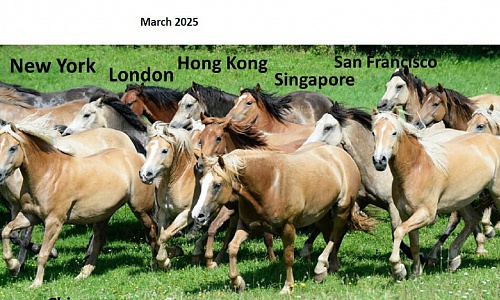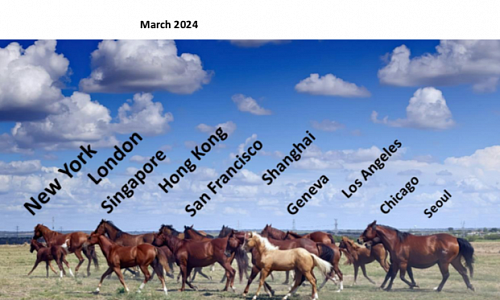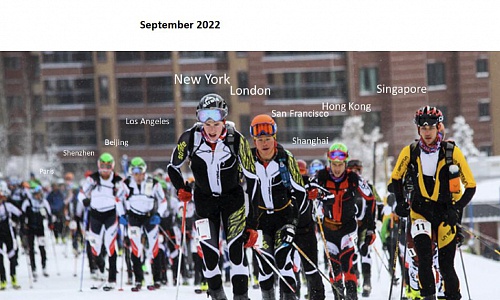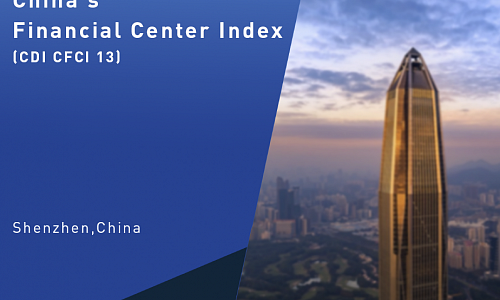The post Covid-19 World will be more or less globalized?
Information
Prof. Fan Gang, President of CDI, held a discussion with Michele Geraci, former Under-Secretary of State for the Italian Ministry of Economic Development on “the post Covid-19 World will be more or less globalized”. The two economists shared their analyses about the post Coronavirus outbreak with particular attention towards the forces that will push the World into a new economic equilibrium. They provided insights and arguments from the European and Chinese points of view on the geo-economic balance that is likely to arise after the crisis.
Date: April 23, 2020
Host: CDI and The European House – Ambrosetti
Theme: The post Covid-19 World will be more or less globalized?
Focusing on “six stabilities,” while struggling to grow
The Chinese economy was hit hard by the coronavirus in Q1, and GDP fell -6.8% y/y. Because the virus is almost contained in China, economic activities have since March been gradually picking up, and there were clear signs of recovery. Industrial output was down -1.1% y/y, up 12.4 pps from January-February.
Consumption has been hardest hit, largely due to quarantining. Retail sales of social consumption goods fell -19% y/y in Q1, and -15.8% y/y in March, up 4.7 pps from January-February. Trade has so far been largely unaffected. Exports in March were up 2.8% y/y after adjustment, down only 1.4 pps from Q4 2019. Imports were up 2.4% y/y, down 2.8 pps.
Fixed asset investment has been left as the only major factor to keep the economy afloat, because of future weakening overseas demand, and of domestic consumption demand. By March, investment had not recovered to normal levels, falling -9.5% y/y, up 15 pps from January-February.
CPI eventually fell, and was down -0.6% m/m after adjustment, and up 4.3% y/y in March, down 1 pps from January-February. The ex-factory price index of industrial goods fell -1% m/m, and was down -1.5% y/y. PPI fell -1.1% m/m, and was down -1.6% y/y. Major financial indicators are the only ones not negatively impacted. M2 rose 10.1% y/y, and M1 rose 5% y/y, up 1.4 and 0.2 pps respectively from the previous month.
On April 17th, President Xi Jinping chaired a major meeting of the Politburo, China’s highest policy decisionmaking body, which promised to step up the magnitude of policies to achieve the country’s goal of “six stabilities:” stable employment, trade, financial markets, investment, foreign capital and expectations, on the condition that the virus has been effectively controlled. We believe there will be expansionary monetary and fiscal policies, such as interest rate cuts and accelerated infrastructure construction, but not a mass flooding to the market, per the approach of the Fed. Unlike in other major economies, China has been saving for rainy days to make these policies feasible, with its still-sizable gap with a zero interest rate, low central government debt, sizable state-controlled economy meaning non-cyclical unemployment, implicit social security system meaning unemployed migrant workers still possessing agricultural lands, and a high household saving rate.
Battle against COVID, an opportunity for China, Japan and South Korea to build joint mechanism
Author:Fu, Yongjia, Postdoctoral Research Fellow, China Development Institute
Editor’s Note:Confronting the deadliest virus in a century, China, Japan and South Korea demonstrated remarkable solidarity. The three nations in East Asia are giving helping hands to each other in hard times. In early February, when China’s confirmed cases were climbing, Japan and South Korea provided China with urgently needed protective gears, though they also face the danger of domestic transmission.
Now, when COVID cases are subsiding in the East Asia continent, China has been ramping up efforts to support Japan and South Korea and sending them medical supplies in large quantities. In an era where trust between major countries is running low, such mutual help and aids in combating COVID-19 is an uplifting sign that China, Japan and South Korea could upgrade their cooperation on health issues to a new level.
First, peoples in the three countries share a common cultural heritage and tend to sympathise with each other in the face of natural disasters. Recently, aid workers in the three countries printed classical verses from The Book of Odes (China, 1046-700 BCE), poems composed by Prince Nagaya (Japan, 685-729 CE) and Choe Chiwon (Korea, 857 CE) on packages of medical supplies as a unique way of expressing solidarity. Looking back at history, we can see the three nations had also proactively come to each other’s help during massive disasters such as the 2008 Sichuan earthquake and the 2011 Tohoku earthquake and tsunami. Warm memories like these provide an optimal starting point to pool the three countries’ resources toward disease prevention.
Second, China, Japan and South Korea’s respective responses to the pandemic bear similarities, which is conducive to a consensus on how to deal with a large-scale health emergency. In fighting COVID, the Chinese government showed strong determination, carried out the lockdown, reversed the trend, stopped the contagion and restarted the economy. Meanwhile, with mass testing, the use of big data and contact-tracing technology, South Korea implemented a nuanced approach that flattens the curve without shutting down the entire economy. On the other hand, Japan has been exploring a softer approach and trying to keep COVID’s disturbance to the national economy to the minimum. Despite their differences, China’s ‘hard’ solution, Japan’s ‘soft’ approach and Korea’s ‘middle way’ are all based on effective leadership of the government, the values of collectivism and the proper state intervention. These shared traits of the three nations’ responses to the coronavirus could facilitate their collective actions to tackle infectious diseases.
Third, the close economic ties and frequent movement of people between the three countries makes joint mechanism against infectious diseases an absolute necessity. In 2019, China was the biggest trading partner of both Japan and South Korea; while Japan and South Korea were China’s 2nd and 3rd largest trading partner, respectively. China is also South Korea’s biggest export market and its largest origin of imports. As of 2018, Japan remains the largest cumulative investor in China, with US$ 112 billion in investments. Chinese visitors to Japan increased tenfold in the recent ten years, reaching 9.59 million in 2019. Similarly, Chinese visitors to South Korea numbered 8.07 million in 2016. According to the statistics of the Embassy of Japan in China, about 140,000 Japanese citizens live in China, while the number of Chinese citizens residing in Japan amounts to 674,000.
To sum up, China, Japan and South Korea have a shared destiny in the face of contagious diseases. The three countries are so near to each other, their economies are so intertwined, and travellers between them are so numerous, that a disease outbreak in one country will quickly spread to the other two nations. The SARS in 2003 was the first strain of coronavirus posing a threat to entire East Asia. Later, in May 2015, only eight days after Korea reported to the WHO the first domestically confirmed case of MERS, China had seen the first imported case, which incurred as many as a hundred contacts. Although MERS did not spread widely in Japan and China, it did show the weakness in the disease prevention system in East Asia. The current COVID crisis should serve as a ‘wake-up call’ that the three countries should join together to fight the virus and build a joint mechanism to tackle future epidemics:
- China should continue to ramp up its support to Japan and South Korea to stop the pandemic in East Asia. Although China had contained COVID’s spread within its boundary, its national safety will be under continuous threat so long as Japan and South Korea are troubled by the coronavirus crisis. The wisest strategy for China is to aid the two neighbours and make East Asia free of COVID as soon as possible. Therefore, China should provide more protective gears and medical supplies to Japan and South Korea, send experts and volunteer teams to the affected areas and provide infrastructural support should it be convenient.
- The three countries could explore new ways to resume international travel between them. The pandemic had locked borders and crippled international travel. The reopening of the closed borders still poses hard challenges for most countries. In light of this, the immigration departments of the three countries should carry out joint inspections at each other’s border, stopping high-risk persons from boarding planes and ships. Moreover, the three countries could share their screening and testing results, create ‘health passports’ for international travellers. By using smartphone apps and Bluetooth technology, the three nations could offer travellers an option to isolate themselves at their own homes before travel, which significantly reduces the cost of mass quarantine.
- China, Japan and South Korea should build a long-term joint mechanism to deal with future outbreaks of contagious diseases. They should make full use of the goodwill accumulated in fighting COVID and turn the temporary measures during the crisis into long-term institutions. For example, the three parties could maintain a permanent green channel for crucial medical supplies. To ensure swift and proper treatment of each other’s citizens, governments should also negotiate the mutual recognition of medical insurance regarding epidemics. Last but not least, the three countries should take collective actions to secure the supply chain in East Asia, relieve the tax burden of companies and protect the industries of the region from future disasters.
Zhu Xihan
Research Assistant
Research Focus
Urban Development, Urbanization, Industrial Planning, Commerce, Regional Economics
Education
Master of Science in Advanced Information System, Hong Kong Baptist University
Projects
Study on Spatial Layout and Industrial Development of Zhuhai Commerce and Logistics Center, 2018
Project Planning and Industrial Spatial Layout of Chencun Flower Town Project Foshan, 2018
Contact
Email: zhuxihan@cdi.org.cn
Tel:+86-755-2550 6561
Zhou Jing
Research Associate
Research Focus
Economic Statistics, Regional Economics, Blue Economy
Education
Master of Statistics, Guangxi University
Projects
Study on Creating a Modern Marine Fishery Benchmark City in Zhuhai, 2023
Study on the Construction of Shenzhen Marine Industrial Park and the International Benchmarking Strategy of Marine Finance, 2022
Construction Scheme of Modern Marine City in Guangdong Province, 2022
Study on the Construction of Shenzhen Marine Industrial Park and the International Benchmarking Strategy of Marine Finance, 2022
Study on Port-Industry-City Integrated Development of Yantian District Shenzhen, 2022
Study on Statistical Monitoring System of Strategic Emerging Industries and High-quality Development in the New Development Stage of Dongguan (GDP>RMB 1 trillion, Population>10 million), 2022
Study on Promoting High-quality Development of Marine Economy in Shenzhen-Shanwei Special Cooperation Zone, 2022
Report on the Development of Shenzhen Marine Industry in 2022, 2022
Pilot Demonstration Study on Peak Carbon Emission and Carbon Neutralization of Shenzhen, 2021
Study on Bay Enterprises Entering Guangxi (Undertaking Seaward Industries), 2021
Study on the Development Strategy of Dongguan's Open Economy, 2021
Industrial Planning and Business Model Planning of Wuchang Fishing Port Economic Zone in Wanning Hainan, 2021
Study on Industrial and Economic Feasibility of Chengxi Area in Putuo Zhoushan, 2021
Study on Comprehensive Treatment and Sustainable Development of Water Environment in Nanliu River Basin of Guangxi, 2021
Study on Promoting Urban-Rural Integrated Development of Shenzhen-Shanwei Special Cooperation Zone, 2021
Global Ocean Centers - Qingdao Index, 2021
Study on Marine Economy and Industrial Development in Qianhai Shenzhen, 2021
Industrial Planning and Feasibility Study for Hisibi Culture and Sports Innovation Center in Shenzhen, 2021
Comprehensive Development Plan of Emerging Marine Industry Base in Shenzhen, 2020
Technical Service for Marine Economic Management in Qianhai Shenzhen-Hong Kong Modern Service Industry Cooperation Zone, 2020
Strategies of Developing Yantian District of Shenzhen into a Core Area of Global Maritime Center, 2020
Compilation of 14th Five-Year Plan of Guancheng Subdistrict Dongguan, 2020
Compilation of 14th Five-Year Plan of Yudong New District Yulin City Guangxi, 2020
Development Plan of Shenzhen Guangju Energy Co., Ltd. during the 14th Five-Year Plan Period, 2020
Development Plan of Shenzhen Guangju Holdings Co., Ltd. during the 14th Five-Year Plan Period, 2020
Study on Transformation Strategy and Industrial Planning of Dachanwan Area in Shenzhen, 2020
Preliminary Study on High-quality Development of Marine Economy in Guangdong during the 14th Five-Year Plan Period, 2020
Study on Industrial and Economic Development of Smart Bao'an District Shenzhen, 2019
Master Plan of Beihai's Marine Economic Development Demonstration Zone, 2019
Study on Strengthening Blue Economy and Building Marine Area of Guangxi Zhuang Autonomous Region during 14th Five-Year Plan, 2019
Study on Conception of Economic and Social Development in Yulin during 14th Five-Year Plan, 2019
Construction Plan of Luosha Community Service Center and Site Selection of Government Service Center in Guancheng Sub-District Dongguan, 2019
Study on Evaluation System and Benefit Sharing Mechanism of Beihai-Qinzhou-Fangchenggang Integration, 2019 Study on Development and Operation Mode of China-EU Blue Industrial Park, 2018
Policy Recommendation Based on National Marine Economy Survey of Shenzhen, 2017
Survey on Marine Economy of Seven Non-Coastal Cities of First National Survey on Marine Economy in Guangdong Province, 2016
Catalogue for Shenzhen Ocean Industries and Products, 2016
Report on Future Development of Ocean Industry in Shenzhen, 2016
Report on Industry and Commerce in Shenzhen, 2016
Shenzhen Marine and Maritime Statistical Investigation, 2015
Development Plan on Shenzhen Maritime Cultural Development, 2014
Contact
Email: zhoujing@cdi.org.cn
Tel:+86-755-8247 1431
Zheng Yujie
Zheng Yujie is the Assistant President of China Development Institute. He is also expert of the Science and Technology Group of Shenzhen Pilot Demonstration Zone, member of the Standing Committee of the CPPCC Luohu District, Shenzhen, and President of the Luohu District Intellectual Association. He has been engaging in government decision-making research in the fields of urban economic development and strategic emerging industry planning throughout his career. He has presided over or participated in over a dozen of development planning research projects commissioned by national ministries and local governments, including "Research on Guangdong-Hong Kong-Macao Greater Bay Area: A World-class Science and Technology Innovation", "Policy Research on Shenzhen's Construction of an International Science and Technology Industry Innovation Center". His published books include "Dual Circulation: New Development Pattern for the 14th Five Year Plan Period".
Research Focus
Regional Economics, Urban Development, New Economy, and Guangdong-Hong Kong-Macao Greater Bay Area
Education
Master of Management, Tsinghua University
Projects
Study on Key Projects of Invest Shenzhen in the “13th Five Year Plan” Period,2016
China’s Opening Up Beige Book (2014-2015)
Reflection on China's Urbanization and Metropolises,2015
13th Five Year Plan of Quanzhou City, Fujian Province,2015
13th Five Year Plan of Shishi City, Fujian Province,2015
13th Five Year Plan of Bishan District, Chongqing Municipality,2015
Study on Accounting Systems and Methods for Residential Property Rental in the U.S.,2014
New-style Urbanization Planning of Quanzhou, Fujian Province,2014
Study on City-industry Integration of Hangzhou Bay New Zone, Ningbo City,2014
Industrial Plan and Policy Study of Shenzhen International Biological Valley,2013
Master Plan for Comprehensive Reform of Private Economies in Quanzhou, Fujian Province,2013
Positioning and Coordinated Development Plan for Binhai New Area, Xiamen Bay,2011
Publications
Wu, L.,&Zheng, Y. (2009).Study on the Competitiveness of Chinese Container Port.Beijing: China Economic Publishing House.
Contact
Email: zyj@cdi.org.cn
Tel:+86-755-82471317
Zheng Xin
Research Fellow
Research Focus
Urbanization, Rural Development, and Public Governance
Education
Ph.D. in Economics, Graduate School of Chinese Academy of Social Sciences
Projects
Functional Orientation Research of Urban Renewal Program for SCC Cultural Innovation Center,2016
Study on City Operation Framework of China Fortune Land Development Co., Ltd,2016
13th Five Year Plan of Futian District, Shenzhen,2015
13th Five Year Plan of Dadukou District, Chongqing Municipality,2015
Construction and Development Plan of Dashihua New District, Chongqing Municipality,2015
13th Five Year Plan of Jinkou Sub-District Office, Wuhan City,2015
Study on Eco-Compensation Mechanism for Environmentally Friendly Facilities in Shenzhen,2015
Study on Urban and Rural Coordinated Development of Gu’an New City, Hebei Province,2015
Urban Renewal Strategy for the Western Part of Shiwan, Foshan City,2015
Study on Accounting Systems and Methods for Residential Property Rental in the U.S.,2014
Study on the Innovation of Social and Economic Indicator System for the 13th Five-Year Plan,2014
Proposal for the 13th Five-Year Planning of Futian District, Shenzhen,2014
Consulting on Historically Reserved Issues of Rural Shareholding Cooperatives in Nanhai District, Foshan City,2014
Policy on Improving Living Standards of Local Residents in Gu’an New City, Hebei Province,2014
Urban-rural Integration Strategy of Yuelu District, Changsha City, Hunan Province,2013
Problems and Countermeasures in Rural Area of Wangniudun Township, Dongguan City, Guangdong Province,2013
Contact
Email: zhxin@cdi.org.cn
Tel:+86-0755-82470053
Zhang Yuge
Senior Research Fellow and Director, Department of Hong Kong, Macao and Regional Development
Research Focus
Opening-Up Policy, Guangdong-Hong Kong-Macao Greater Bay Area, Hong Kong and Macao and Regional Economics
Education
Master of Literature,Liaoning Normal University
Projects
Policy and Platform for a New Model of Shenzhen Opening to Hong Kong and Macao, 2018
Strengthening and Enhancing Macao's Connection Functions, 2018
Formulate and Improve Policy for Hong Kong and Macao Residents in Hengqin (Zhuhai), 2018
Study on Developing Financial Supporting the Construction of Greater Bay Area, 2018
Survey on Employment and Entrepreneurship of Hong Kong and Macao Youth in Luohu, 2018
Study on Development Opportunities for China General Nuclear Power Corporation, 2018
Study on Further Facilitating the Development of Hong Kong Professionals in Shenzhen,2018
Providing More Favorable Conditions for Hong Kong and Macao Compatriots to Work and Live in Shenzhen (Youth in Particular), 2018
Policy Suggestions Regarding the Flow of Personnel in Greater Bay Area, 2018
China's World-Class Bay Area: Innovation and Urban Transformation, 2017
Study on Guangdong-Hong Kong-Macao Greater Bay Area and Macao's Strategic Choice, 2017
Study on Macao Financial Development Strategy, 2017
Study on Development of Lok Ma Chau Loop and Surrounding Areas, 2017
Efficient Movement of Factors of Production: Case Study on Lok Ma Chau Loop, 2017
Study on Sino-Singapore Tianjin Eco-City, 2017
Documentary Script of Shenzhen-Hong Kong Cooperation Twenty Years,2017
Study on CGN Ling'ao Nuclear Power Project,2017
Study on Making New Breakthroughs in Major Areas of Cooperation Between Shenzhen and HK, 2016
Study on Development Strategy of Shenzhen and Hong Kong Port (2016-2030), 2016
Report and Implementation Plan on Construction of Modern Think Tank System in Shenzhen, 2015
Study on Shenzhen’s Role in Solving Hong Kong’s Teenage Problems, 2015
Study on Economic Positioning and Development Models of Hong Kong, 2014
Study on Shenzhen’s Role in Further Promoting Prosperity and Stability of Hong Kong, 2014
Study on Shenzhen-Hong Kong Cooperation for the Development of Gulf Economy, 2014
Report on the Transformation of HK Economy and Capital Structure after the Handover, 2013
Study on Shenzhen-Hong Kong Cross-boundary Students, 2013
Evaluation and Policy Suggestions of Economic and Social Governance by Hong Kong SAR Government Over Past 15 Years Since its Establishment, 2012
Publications
Zhang, Y. (2016).Hong Kong’s Economy at the Crossroad. Beijing: China Economic Publishing House.
Contact
Email: zhangyg@cdi.org.cn
Tel:+86-755-8247 0725
Zhang Yiyao
Research Associate
Research Focus
Regional Economics
Education
Master of Economics, South China University of Technology
Contact
Email: zyy@cdi.org.cn
Tel:+86-755-82470922
Zeng Zhen
Senior Research Fellow and Directorof Institute of Urbanization
Research Focus
Macroeconomics, Opening-Up Policy, Guangdong-Hong Kong-Macao Greater Bay Area, Special Economic Zone, Urban Development, Urbanization, Industrial Planning, Urban Planning, Blue Economy, andRegional Analysis
Education
Master inInternational Shipping Logistics, Hong Kong PolytechUniversity
Projects
Action Strategy for Dongguan in the Construction of Greater Bay Area, 2018
Strategy for Integrating Ronggui Street in Shunde District of Foshan into Greater Bay Area, 2018
Study on Development Strategy of Foshan Shunde City Center, 2018
Strategy to Improve Urban Quality of Daliang Neighborhood in Shunde District Foshan, 2018
Industrial Development and Spatial Layout of Leliu Town in Shunde District Foshan, 2018
Project Planning and Industrial Spatial Layout of Chencun Flower Town Project Foshan, 2018
Project and Concept Planning of Longjiantian Science and Technology Town of Dongguan, 2018
Study on Mechanism of "Regional Coordination Group" of Dongguan Water Township, 2018
Regional Development Against the Backdrop of Greater Bay Area, 2017
Study on Spatial Layout and Industrial Development of Zhuhai Commerce and Logistics Center, 2017
Research on the Strategy of Dongguan under the Background of Guangdong-Hong Kong-Macao Greater Bay Area,2017
Contact
Email: htzz@cdi.org.cn
Tel:+86-755-8247 1190


















